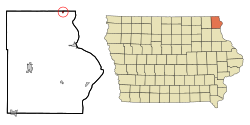History
New Albin was platted in 1872 shortly after the Chicago, Dubuque and Minnesota Railroad had been built through that territory. [4] [5] It was named for the son of a railroad official, [6] who died from burns after falling into a bonfire. [7] Residents originally wanted to name the community 'Albin'; however, the post office claimed this would cause confusion with the already existing towns of Albia and Albion, so the name 'New Albion' was chosen instead. [8]
On May 20, 1895, New Albion was officially incorporated as a city. [9]
Highway 26 (originally Highway 182) was constructed through New Albin in 1936. [10]
Demographics
2020 census
As of the census of 2020, [14] there were 432 people, 206 households, and 114 families residing in the city. The population density was 1,712.2 inhabitants per square mile (661.1/km2). There were 239 housing units at an average density of 947.2 per square mile (365.7/km2). The racial makeup of the city was 97.2% White, 0.0% Black or African American, 0.5% Native American, 0.0% Asian, 0.0% Pacific Islander, 0.2% from other races and 2.1% from two or more races. Hispanic or Latino persons of any race comprised 0.5% of the population.
Of the 206 households, 21.8% of which had children under the age of 18 living with them, 41.3% were married couples living together, 10.7% were cohabitating couples, 23.3% had a female householder with no spouse or partner present and 24.8% had a male householder with no spouse or partner present. 44.7% of all households were non-families. 34.0% of all households were made up of individuals, 18.0% had someone living alone who was 65 years old or older.
The median age in the city was 45.6 years. 21.1% of the residents were under the age of 20; 5.3% were between the ages of 20 and 24; 22.9% were from 25 and 44; 26.6% were from 45 and 64; and 24.1% were 65 years of age or older. The gender makeup of the city was 51.9% male and 48.1% female.
2010 census
As of the census [15] of 2010, there were 522 people, 222 households, and 138 families living in the city. The population density was 2,175.0 inhabitants per square mile (839.8/km2). There were 257 housing units at an average density of 1,070.8 per square mile (413.4/km2). The racial makeup of the city was 97.1% White, 0.4% African American, 1.5% Native American, 0.4% Asian, 0.2% from other races, and 0.4% from two or more races. Hispanic or Latino of any race were 0.4% of the population.
There were 222 households, of which 27.9% had children under the age of 18 living with them, 50.5% were married couples living together, 7.7% had a female householder with no husband present, 4.1% had a male householder with no wife present, and 37.8% were non-families. 32.9% of all households were made up of individuals, and 17.6% had someone living alone who was 65 years of age or older. The average household size was 2.35 and the average family size was 3.01.
The median age in the city was 43.5 years. 25.3% of residents were under the age of 18; 5.6% were between the ages of 18 and 24; 21.1% were from 25 to 44; 25.7% were from 45 to 64; and 22.2% were 65 years of age or older. The gender makeup of the city was 49.6% male and 50.4% female.
2000 census
As of the census [16] of 2000, there were 527 people, 226 households, and 139 families living in the city. The population density was 2,390.8 inhabitants per square mile (923.1/km2). There were 247 housing units at an average density of 1,120.5 per square mile (432.6/km2). The racial makeup of the city was 97.15% White, 1.14% Native American, 0.19% from other races, and 1.52% from two or more races. Hispanic or Latino of any race were 0.57% of the population.
There were 226 households, out of which 29.2% had children under the age of 18 living with them, 50.0% were married couples living together, 8.0% had a female householder with no husband present, and 38.1% were non-families. 34.1% of all households were made up of individuals, and 15.9% had someone living alone who was 65 years of age or older. The average household size was 2.33 and the average family size was 2.99.
Age spread: 26.9% under the age of 18, 7.6% from 18 to 24, 25.8% from 25 to 44, 19.4% from 45 to 64, and 20.3% who were 65 years of age or older. The median age was 38 years. For every 100 females, there were 95.2 males. For every 100 females age 18 and over, there were 96.4 males.
The median income for a household in the city was $32,981, and the median income for a family was $36,667. Males had a median income of $26,625 versus $19,375 for females. The per capita income for the city was $14,049. About 4.5% of families and 6.6% of the population were below the poverty line, including 6.3% of those under age 18 and 8.5% of those age 65 or over.
This page is based on this
Wikipedia article Text is available under the
CC BY-SA 4.0 license; additional terms may apply.
Images, videos and audio are available under their respective licenses.





